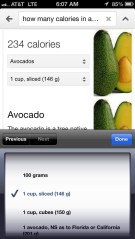
On Monday, Google added a new feature to its search capabilities: in-depth and accurate nutrition information.
Before this week, if you Googled, “How many calories are in a carrot?” you would see a mumbo-jumbo list of varying calorie counts from many different sources — and often the results conflicted. Now, whether you are searching on desktop or using voice search on your smartphone, users can get in-depth, clear and curated results to their dietary questions.
“We’ve seen such an increase in queries over time related to health. Everything from questions of how many calories are in a banana, to how much protein is in a steak,” says Roya Soleimani, a Google global-communications and public-affairs representative for search. “Unfortunately, until now, there was no easy way to answer that question.”
(MORE: The Knowledge Graph: Google’s Next Frontier for Search)
The new data is pulled primarily from the nutritional database maintained by the U.S. Department of Agriculture. There’s nutritional information including calories, carbs and proteins for foods from broccoli to cupcakes. There’s more complex meals like burritos and chow mein, but Google is still perfecting foods and meals with multiple ingredients — not everything has a profile yet, including fast-food fare.
Users can also better tailor the information to their eating habits by changing serving sizes via a drop-down box in a specific food profile.
The Google nutrition-search feature is a part of the Google Knowledge Graph, which was rolled out in May last year. TIME’s Harry McCracken wrote:
Google says it’s been working on populating the Knowledge Graph for the past two years: its database now includes half a billion people, places and things, and 3.5 billion attributes and connections that define them. It’s exposing this deeper understanding of the world in some new features that are beginning to roll out today — you may not see them immediately — and has wildly ambitious plans to build on them in the future.
Nutritional data is one of the newest features. It was rolled out to 10% of users last week and is now available to everyone. The Knowledge Graph puts all the information gathered into a box on the right-hand side of the main search results. You get your calorie counts, along with options to learn more about other related topics. “If I look up calories in an avocado, I will get that information, but I will also get the potassium levels and other nutrient levels,” says Soleimani. “It gives people the answers they are looking for, quickly and accurately. Hopefully it will empower people to make healthy decisions.”
Comparison capabilities will be the first additions to the nutrition-search information, so users can choose between flank steak, say, vs. a fillet.
The new feature is even more useful when using voice search. Not only does voice search pull up the same valuable information, but it also remembers the context of your question for your next inquiry.
For example:
Question: “How many calories are in beer?”
Google response: “154 calories in one can.”
Question: “How many carbs?”
Google response: “13 g of total carbohydrates in one can.”
(MORE: Why People Don’t Read Nutrition Labels)
“This is the beginning of better answers and the future of where search is going,” says Soleimani. “It will be more conversational, and provide you a better answer, faster.”
Learn more about Google Knowledge Graph here:
[youtube=http://www.youtube.com/watch?v=mmQl6VGvX-c&feature=player_embedded#!]


